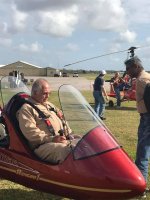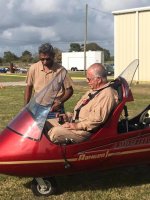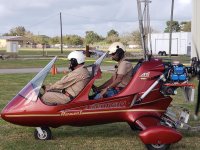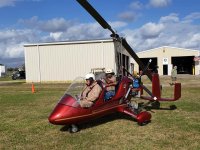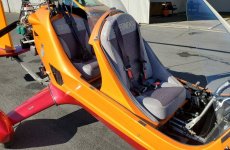- Joined
- Oct 30, 2003
- Messages
- 18,376
- Location
- Santa Maria, California
- Aircraft
- Givens Predator
- Total Flight Time
- 2600+ in rotorcraft
My flight review in an American Ranger powered by a Rotax 915.
Tony is a good friend and a very good flight instructor.
He recently installed a Rotax 915 in his American Ranger.
The Lone Star Rotorcraft Club in Anahuac, TX was having a fly in and Tony offered to put me up in Katy, TX and give me a flight review in his AR1.
I have a primary student that is going to train in his aircraft for private pilot that is not quite ready to fly so I ducked out for a week while he works to make his gyroplane airworthy in my hangar. He was under the supervision of a good air frame and power plant mechanic.
I love any excuse for a road trip.
I had not flown anything powered by a Rotax 915 and I was excited about the opportunity.
I have flown four AR1s and instructed in one. I felt it was a good platform for the Rotax 915. In my opinion it is the nicest two place open tandem gyroplane available today in the USA.
We spent most of the morning doing a careful preflight and greeting friends at the event.
After lunch we spent some time getting me acquainted with the aircraft and planning the flight review.
Various takeoffs and landings, turns around a point, S turns over a road, recognition and recovery from low airspeed and a high rate of descent and various landings including what I refer to as the elevator descent to land.
I have a lot of hours in a lot of different gyroplanes and I find each one flies a little differently.
I prefer steam gages and have to take extra time to understand a flight display like Tony’s AR1 has.
I teach my clients to keep their eyes outside and use the flight instruments to calibrate their sight picture with a quick instrument sweep. To do this I must understand the displays and what I am looking for during the sweep.
Flying at an unfamiliar airport is also a challenge for me as all of my navigation and radio calls are based on the familiar landmarks around the familiar airport.
It would be safe to say most people feel I spend way too much time in pre-flight inspection and flight preparation.
One thing I particularly liked and plan to incorporate in my own flight instruction is in addition the normal three step exchange of controls. Tony also had me repeat back “follow me on the controls” for each maneuver he would demonstrate.
Tony demonstrated the first takeoff on the 60 foot wide 3005 foot long runway 12 and then gave me the flight controls as we climbed out with a departure to the south west.
I was pleased with how smooth the cyclic was and how light the control inputs were.
I immediately climbed two hundred feet too high and briefly struggled with airspeed as I became acquainted with the sight picture. Once I found my references airspeed became easy (plus or minus five miles per hour) and I had less trouble with altitude excursions.
I used Ross Sterling Avenue for my S turns over a road and a pump jack for my turns around a point.
Tony has no inflight adjustable trim on his AR1 and she requires a slight forward pressure to reach the target airspeed of sixty miles per hour.
When it was time to return to the airport I told Tony I was lost. East Texas is somewhat featureless and Anahuac is particularly flat. I had trouble finding the airport till I was nearly on top of it. We were not using a GPS and next time I will wear my prescription goggles as I had some tearing challenges.
After several different takeoffs and landings including a zero airspeed vertical descent I felt comfortable enough to give her full power on the takeoff roll and she leapt into the air without any drama and climbed out with alacrity with no required rudder input.
We lined up on the nineteen hundred foot long grass runway (17) for a stop and go with a considerable gusting cross wind. I went around the first time because I was a little high and not comfortable taking off in the distance that would have remained after a stop and go.
The next pass was a lovely, text book stop and go and it appears I could have managed the takeoff easily in the distance remaining on the first attempt despite the grass being a little wet. The AR1 has generous rudder authority.
There was no perceptible turbo lag; just smooth, steady power directly related to the throttle position.
I was not aware of any power-pitch-yaw coupling from full power to idle at any speed we flew.
Torque roll appeared absent to me and very little rudder was required to deal with the gusting wind on takeoff.
In short the American Ranger with a 915 is a delight to fly with no vices I could detect.
Tony is the 41st instructor I have flown with and in my opinion one of the best.
We have very different styles and Tony never once took the controls despite the divergence.
Only once did he even say anything as I mismanaged his aircraft. I had ballooned up on my flare and Tony felt I should use power to help manage the resulting aggressive descent. I was just more aggressive in the final flare and it worked out fine. I am not certain I would have stayed off the controls in a similar situation. Landing is an edgy time for me as a flight instructor.
Our de-brief went well and Tony went to fly with other clients while I enjoyed interacting with the many people who attended the event.
I am proud to have Tony’s name in my log book.
Tony is a good friend and a very good flight instructor.
He recently installed a Rotax 915 in his American Ranger.
The Lone Star Rotorcraft Club in Anahuac, TX was having a fly in and Tony offered to put me up in Katy, TX and give me a flight review in his AR1.
I have a primary student that is going to train in his aircraft for private pilot that is not quite ready to fly so I ducked out for a week while he works to make his gyroplane airworthy in my hangar. He was under the supervision of a good air frame and power plant mechanic.
I love any excuse for a road trip.
I had not flown anything powered by a Rotax 915 and I was excited about the opportunity.
I have flown four AR1s and instructed in one. I felt it was a good platform for the Rotax 915. In my opinion it is the nicest two place open tandem gyroplane available today in the USA.
We spent most of the morning doing a careful preflight and greeting friends at the event.
After lunch we spent some time getting me acquainted with the aircraft and planning the flight review.
Various takeoffs and landings, turns around a point, S turns over a road, recognition and recovery from low airspeed and a high rate of descent and various landings including what I refer to as the elevator descent to land.
I have a lot of hours in a lot of different gyroplanes and I find each one flies a little differently.
I prefer steam gages and have to take extra time to understand a flight display like Tony’s AR1 has.
I teach my clients to keep their eyes outside and use the flight instruments to calibrate their sight picture with a quick instrument sweep. To do this I must understand the displays and what I am looking for during the sweep.
Flying at an unfamiliar airport is also a challenge for me as all of my navigation and radio calls are based on the familiar landmarks around the familiar airport.
It would be safe to say most people feel I spend way too much time in pre-flight inspection and flight preparation.
One thing I particularly liked and plan to incorporate in my own flight instruction is in addition the normal three step exchange of controls. Tony also had me repeat back “follow me on the controls” for each maneuver he would demonstrate.
Tony demonstrated the first takeoff on the 60 foot wide 3005 foot long runway 12 and then gave me the flight controls as we climbed out with a departure to the south west.
I was pleased with how smooth the cyclic was and how light the control inputs were.
I immediately climbed two hundred feet too high and briefly struggled with airspeed as I became acquainted with the sight picture. Once I found my references airspeed became easy (plus or minus five miles per hour) and I had less trouble with altitude excursions.
I used Ross Sterling Avenue for my S turns over a road and a pump jack for my turns around a point.
Tony has no inflight adjustable trim on his AR1 and she requires a slight forward pressure to reach the target airspeed of sixty miles per hour.
When it was time to return to the airport I told Tony I was lost. East Texas is somewhat featureless and Anahuac is particularly flat. I had trouble finding the airport till I was nearly on top of it. We were not using a GPS and next time I will wear my prescription goggles as I had some tearing challenges.
After several different takeoffs and landings including a zero airspeed vertical descent I felt comfortable enough to give her full power on the takeoff roll and she leapt into the air without any drama and climbed out with alacrity with no required rudder input.
We lined up on the nineteen hundred foot long grass runway (17) for a stop and go with a considerable gusting cross wind. I went around the first time because I was a little high and not comfortable taking off in the distance that would have remained after a stop and go.
The next pass was a lovely, text book stop and go and it appears I could have managed the takeoff easily in the distance remaining on the first attempt despite the grass being a little wet. The AR1 has generous rudder authority.
There was no perceptible turbo lag; just smooth, steady power directly related to the throttle position.
I was not aware of any power-pitch-yaw coupling from full power to idle at any speed we flew.
Torque roll appeared absent to me and very little rudder was required to deal with the gusting wind on takeoff.
In short the American Ranger with a 915 is a delight to fly with no vices I could detect.
Tony is the 41st instructor I have flown with and in my opinion one of the best.
We have very different styles and Tony never once took the controls despite the divergence.
Only once did he even say anything as I mismanaged his aircraft. I had ballooned up on my flare and Tony felt I should use power to help manage the resulting aggressive descent. I was just more aggressive in the final flare and it worked out fine. I am not certain I would have stayed off the controls in a similar situation. Landing is an edgy time for me as a flight instructor.
Our de-brief went well and Tony went to fly with other clients while I enjoyed interacting with the many people who attended the event.
I am proud to have Tony’s name in my log book.
Attachments
Last edited:

